FLYING SCOTSMAN

A VISIT TO THIS FAMOUS LOCOMOTIVE
In April 2018 the Flying Scotsman made a visit to the Swanage Railway where it spent some time hauling passenger trains, all packed to capacity. When it had finished these duties it was put on "static" display at Corfe station when members of the public could pay a visit and admire this locomotive. Static display meant the engine was kept in "light steam" i.e. the fire was lit and steam was being generated but not sufficient for motion. Pre booked groups were allowed into the fenced off area and joy of joys, were allowed onto the footplate to examine the controls etc and to exit by means of the tender corridor to the Pullman coach which once was a regular part of the train "The Flying Scotsman".
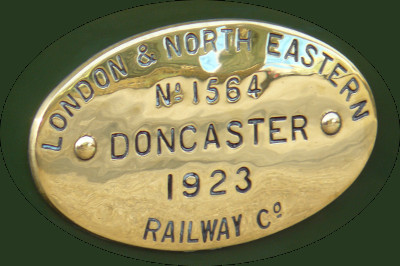 Works Plate with built date. (image P1070560.jpg)
Works Plate with built date. (image P1070560.jpg)
At the time this photograph was taken the locomotive was 96 years old and still going strong, thanks to the knowledge and dedication of a team of engineers. Of course, parts wear out and need replacing but it is still essentially the same locomotive that left Doncaster works all those years ago. The heart of any steam engine is the boiler and this has been replaced over the years.
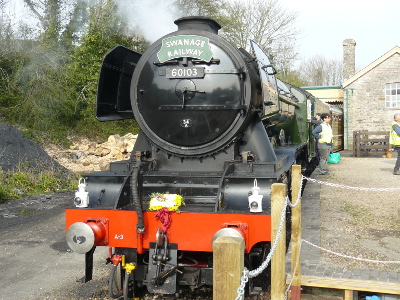 Corfe Station Goods Yard. (image P1070554)
Corfe Station Goods Yard. (image P1070554)
As can be seen from the photograph a special platform had been constructed for the purpose of viewing. With a limited number of people forming a group the entire visit was very friendly and pleasant - and no one got in the way of your pictures! Why there is a bouquet of flowers on the front is unknown.
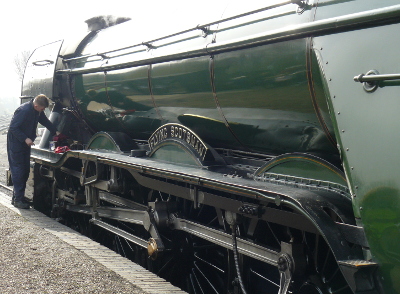 Always something to do. (image P1070562)
Always something to do. (image P1070562)
There is always something to do to keep an engine this size looking smart and as new. What is being given some TLC is some exposed pipework.
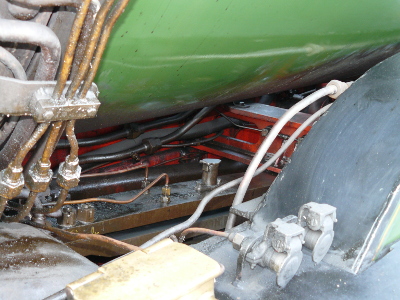 Exposed pipework (image P1070556)
Exposed pipework (image P1070556)
Here is some of the small exposed pipework. The Flying Scotsman is a working engine and pulls many excursion trains during its running season. For example in May it is going to run from York to London Paddington via Derby and Oxford and those pipes are out in all weathers so need keeping an eye on.
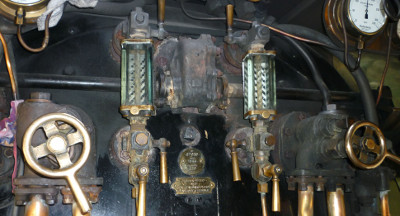 The Glasses (water levels) (image P1010159)
The Glasses (water levels) (image P1010159)
At last it was our turn to mount the footplate and enter the cab. The first thing to notice is "The Glasses", perhaps the most important instrument of the lot. The chunky looking glass covers the slender pipes for protection. Those pipes show the water levels in the boiler. It would be disastrous not only for the engine but also the crew if there was insufficient water. Think of turning on your electric kettle at home with no water in it then multiply that by some order of magnitude. You may by able to make out two small bronze plates on the bulkhead between to glasses. The round one says "27020 Date 1944 Pressure 220 lbs/sqinch" and the oblong one "Boiler fitted with BR standard plugs Washout & Fusible". What this means is that if the fire is burning at near normal temperatures and there is low water in the boiler, the plug melts to allow water to flow into the firebox to put out the fire thereby lessening major damage to the engine.
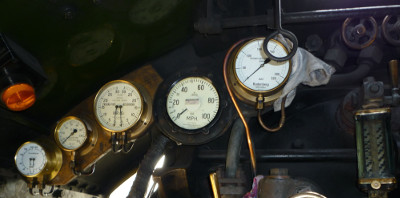 Braking System Gauges (image P1010161)
Braking System Gauges (image P1010161)
Any train driver will be taught how to get it moving but the next big question he (or she) will ask and demand an answer is "how do I stop it?". After all they are the people in the very front seat. This picture also neatly illustrates the problem of trying to run old engines on the modern network. The Scotsman was a LNER locomotive and was built to run using their systems. Even in those old days there were two types of braking systems. The vacuum brake found mainly on the GWR and the air pressure one found mainly on the Southern. The principle is the same for both; a break in the pipe destroys the vacuum/air pressure and the brake is applied automatically. The driver needs to know the state of these systems so taking the gauges from right to left they are : steam chest pressure; speedometer; vacuum gauge with dual read out train pipe and reservoir vacuum; air pressure; a dual readout pressure gauge train and reservoir. The circular orange object is a night light as there is no back lit illumination for the gauges.
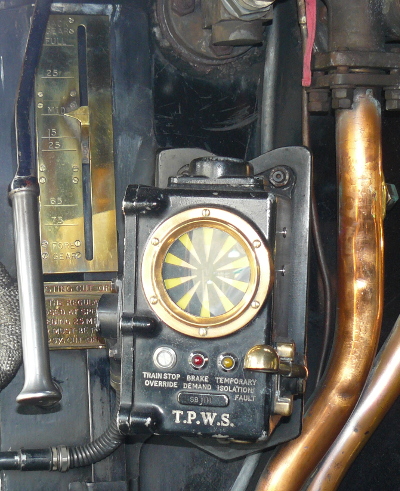 Train & Signal Equipment (image P1070569)
Train & Signal Equipment (image P1070569)
Continuing the theme of stopping and control of the train we come to the interaction with the signaling system. The black box with the yellow and black dial. This is a good example of "new wine into old bottles". The locomotive was never designed for modern signaling systems but if Flying Scotsman is to earn its keep it must comply with the system for the line it is running on. It is not helped by there being, for historical reasons LNER, GWR etc many different types of systems and now the computerised fully automatic modern version not found everywhere at present. What we have on the Scotsman is the TPWS - Train Protection and Warning System which at present enables it to run on most lines. It warns the driver of signals set at red and will bring the train to a stop of a red signal is passed. It sounds a bell or a horn sound depending on whether to signal is green or red and the driver must acknowledge the warning by pressing a key on the box.
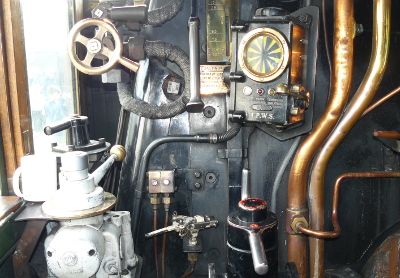 Drivers Position and Controls (image P1070567)
Drivers Position and Controls (image P1070567)
This is the driving position. The driver sits on a small seat immediately behind the controls shown in the photograph. In front of him are the regular to control steam entry to cylinders, brakes and the reverser control plus the all important TPWS system to ensure no signals are passed at red. Let us not overlook the other vital part of any drivers kit, the mug for tea on the extreme left of the picture
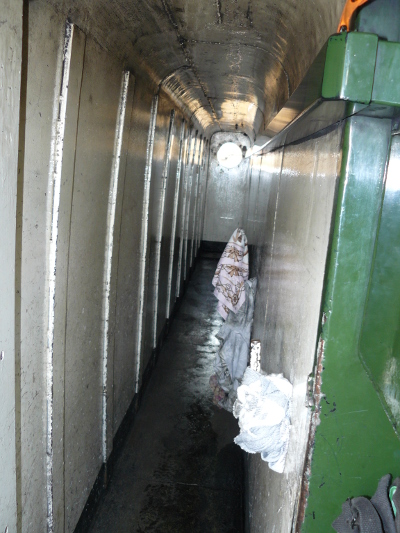 The Tender Corridor (image P1070570)
The Tender Corridor (image P1070570)
Finally our footplate visit came to an end with the only exit allowed being a walk down the corridor the length of the tender. This is only 14 inches wide (36 mm) and I was so pleased that I fitted in it! The peculiar looking objects hanging on the walls were dusters.
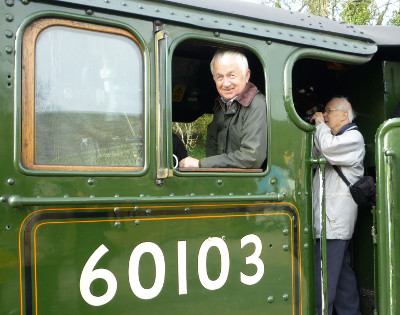 The Old Codgers We hope you have had as much enjoyment reading about our visit as we did actually being there. Sorry you cannot partake of the "Truly Amazing Breakfast" available at the Bankes Arms just up the way from the station which did add a certain element to our morning. If this page has aroused your curiosity regarding the Flying Scotsman locomotive then watch this space page 2 is under construction...
The Old Codgers We hope you have had as much enjoyment reading about our visit as we did actually being there. Sorry you cannot partake of the "Truly Amazing Breakfast" available at the Bankes Arms just up the way from the station which did add a certain element to our morning. If this page has aroused your curiosity regarding the Flying Scotsman locomotive then watch this space page 2 is under construction...

